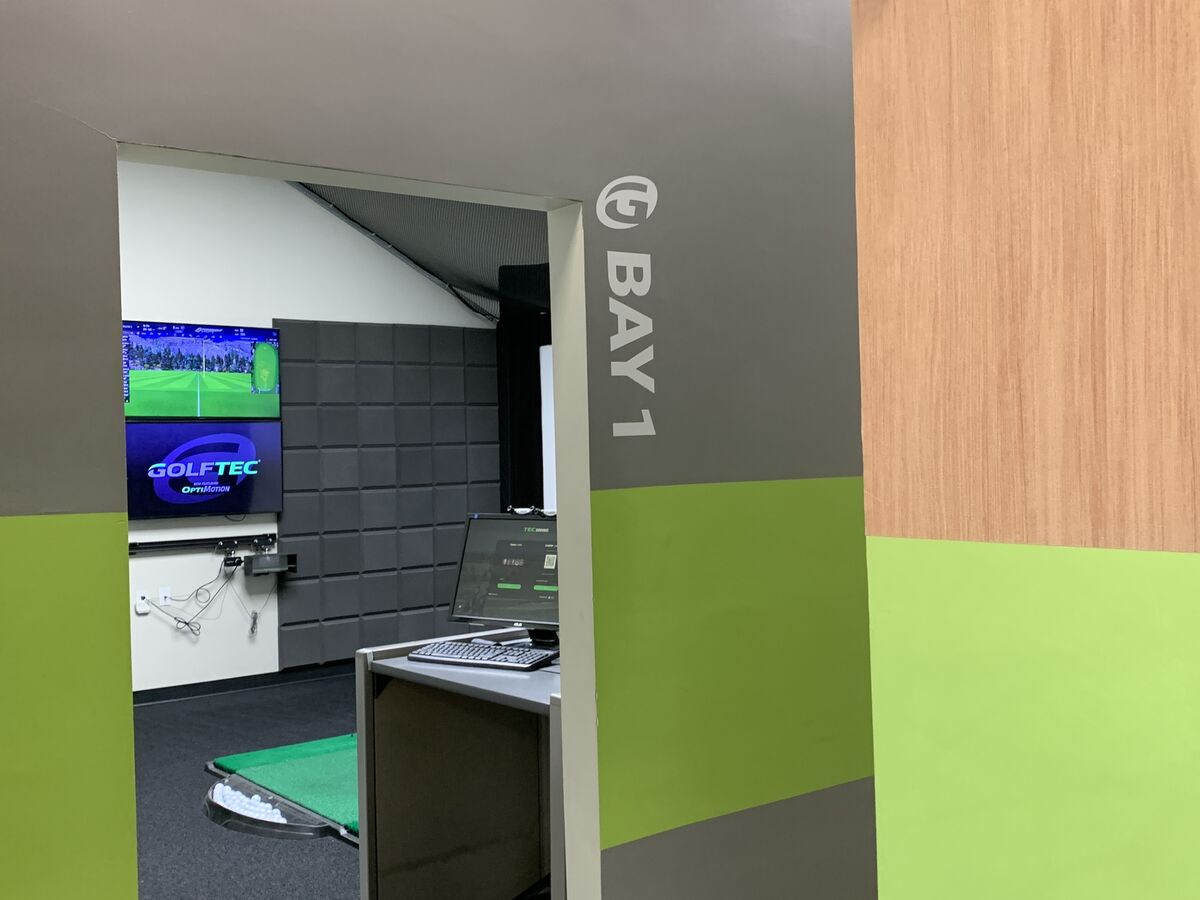GolfTec Club Fitting Review: Pros & Cons Plus Helpful Hacks

Confidence on the golf course is a prerequisite to shooting good scores. The best way to gain complete confidence in your equipment is to be fit by a professional. If you’re considering a club fitting, GolfTec – the nationwide club fitting and lesson powerhouse – is probably on your radar. But is a GolfTec fitting worth it? We visited GolfTec for an undercover club fitting. Here’s our complete GolfTec club fitting review, with pros, cons, and helpful hacks.
Is GolfTec Worth It?

GolfTec Club Fitting: $150-$300 | BOOK NOW
I visited my local GolfTec for an iron fitting, which comes with a sticker price of $150. However, I booked my fitting while GolfTec was running a promotion, and saved $55, so I paid $95 for my fitting.
For $95, I left GolfTec feeling like it was money well spent. At the full $150 rate, it’s still a good experience, but if you have the luxury of time, I recommend checking for discounts. You just might beat the sticker price.
There were plenty of pros and cons from my GolfTec fitting experience, but I left feeling like I’d happily spend that money every 2-3 years just to compare how my current gamers perform against the latest releases. In addition to club technology constantly evolving, my swing is always being tweaked, poked, and prodded as well, and it's helpful to ensure my equipment still suits my game.
My fitting lasted about 90 minutes, and after first establishing a baseline with my current irons, I tested around a dozen head and shaft combinations.
In my iron fitting at GolfTec, I gained some noticeable distance – up to 10 yards – when testing the newest models, but I couldn’t find an iron that got me closer to my goal of hitting more greens. My spin, launch, lateral dispersion, and descent angles were all as good or better with my current set – TaylorMade M5 (2019) – than anything else I tested.
This was really satisfying to see, because even though I was fit for those M5 irons (not at GolfTec), that fitting experience was wildly underwhelming. As a lefty, I only had two iron heads to choose from during that fitting in 2019, and even though I really liked the M5 irons, I didn’t feel like we truly identified those as the best for my swing on planet Earth, just because there were so many other heads I wanted to test but couldn’t.
This GolfTec iron fitting validated that my current irons are in fact perfect for my game and my current goals. That validation alone was worth the $95.
Even if you were fit for your current irons, if your swing, skill level, or goals have evolved over the years since, I recommend a fitting as a check-up every few years.
Helpful Hack
Check GolfTec's fitting prices regularly, as you may occasionally find nice discounts. I saved $55 on my iron fitting by booking during a promotion.
GolfTec Fitting Pricing
GolfTec club fittings cost $150 for each type of club, or you can opt for a full bag fitting for $300. Expect an iron, driver, or wedge fitting to take 60 to 90 minutes.
|
Fitting |
Price |
|
Iron Fitting |
$150 |
|
Driver Fitting |
$150 |
|
Wedge Fitting |
$150 |
|
Full Bag Fitting |
$300 |
GolfTec Club Fitting Review
My GolfTec iron fitting began with a pre-fitting interview. This is an important first step in the process, because it’s an opportunity to get on the same page as your fitter. They can learn about your game, what your goals are on the course, and what your goals are for the fitting session.
My fitter had mistakenly thought I was there for a swing evaluation, so we got most of the way through the swing evaluation interview before realizing I had really booked a fitting. He never asked me what my goals for the fitting were, so later, after getting a baseline with my current clubs, I offered up that information.
Helpful Hack
Always communicate 1 or 2 goals from the fitting with your fitter. Establishing goals gets you and your fitter on the same page, and ensures you’re looking at club performance through the same lens.
Before we started hitting balls, my fitter took my wrist-to-floor measurement and measured my hand. At the end of the fitting, he checked if I needed a lie adjustment as well. These are small but important details that used to be the crux of a club fitting, but can get overlooked with the reliance on launch monitors, so I was happy he checked these boxes.
Goals
My goals for my iron fitting were straightforward: find an iron that will help me hit more greens.
I explained to my fitter that in addition to looking for better lateral dispersion, I was tired of seeing balls land on the green but roll through. A steeper angle of descent and more backspin were priorities over added distance.
Establishing Baselines With Current Gamers

Entering a GolfTec fitting studio
The fun part began with hitting my current 7-iron, and letting GolfTec’s Foresight GCQuad capture my club and ball data. This also gave my fitter an idea of the shaft flex I fit into.
We learned that my backspin and descent angle were both on the low end of the target range, although my fitter mentioned he prefers to see spin rates at the bottom of that range.
Testing
I have one significant complaint about my GolfTec iron fitting. In addition to testing the game improvement range, I mentioned to my fitter that I also wanted to hit a couple muscle back irons, if nothing else, simply for comparison’s sake.
He seemed perplexed that I would even ask, and even though he pulled three muscle back heads for me, he only actually assembled one of them for testing, the TaylorMade P790. I assumed this was because the numbers supported the assumption that I belonged squarely in the GI segment, although he didn’t give feedback on the data from each club.
When I returned home and looked at my data, I was surprised to learn that the P790 outperformed every game improvement iron I tested in backspin, lateral dispersion, and descent angle. These are the metrics we established as top priorities to help me hit and hold more greens. On top of that, the smash factor (efficiency) with the P790 was as good as the best game improvement irons I tested.
The P790 fell behind in speed and distance, and I swung them 2.5 MPH slower than the rest of the pack. Was I putting a more controlled swing on them because I knew they were less forgiving? Would a different shaft flex or weight help bring that speed up? You never know until you test, and since we never tested them further, we’ll never know. This was a pretty disappointing takeaway.
Outside of that experiment, we tested the current line of game improvement irons. From TaylorMade Stealth and Callaway Paradym to PING G430, Cobra Aerojet, and Titleist T300. After every couple combos, we’d compare and toss out any clear losers, or make a shaft-change to a contender to see if we could eek out some better performance. It was a pretty standard fitting, and I enjoyed seeing how each club looked and felt with my swing, and how the performance compared to the pack.
I did, however, run into one additional problem. The club heads used for fittings have a brand-specific piece that connects to the shaft, and not every shaft was available for every head. During my fitting, I really liked the feel of the Cobra Aerojet irons, which gave me similar results to the Callaway Rogue. With the Rogue, we swapped in a lighter shaft and immediately saw improved performance in the most important metrics. I asked if we could try a lighter shaft in the Aerojet to see if we could get a similar improvement, but it wasn’t available.
Even though you can compare countless head and shaft combinations, you can’t expect to test every combination you might want.
The Results
At the end of my fitting, I saw how each of my top contenders compared to each other, and to the M5 irons I currently use. It’s really satisfying to compare the tradeoffs of one set with another, especially for people who like their data.
At the end of the day, my current irons outperformed everything I tested in backspin and dispersion and gave up about two degrees of descent angle and seven yards of carry compared to the best performers from the fitting.
The Callaway Rogue and Paradym irons performed pretty similarly for me, and at nearly half the cost, I choose the Rogue as my top pick from the bunch. However, at around $1,000 for the set to gain a few yards – with some dispersion and backspin tradeoffs – it was an easy decision to stick with my M5 irons.
This information alone was worth the cost of admission.
Pros and Cons of a GolfTec Club Fitting
I had almost too many takeaways to count from my iron fitting at GolfTec. Here are the most important pros and cons that I think you should weigh before you book a GolfTec club fitting.
5 Benefits of a GolfTec Club Fitting
- The 90-minute time slot was the right amount of time for a thorough fitting without feeling rushed
- The fitter took the time to take my wrist-to-floor and hand measurements, and tested my lie and adjustment
- At the end of the fitting, my fitter explained the exact price of the selected set, down to the penny, and sent the data comparison of those clubs to my gamers, along with the breakdown of cost, via email
- The cost of my final recommended build was just under $1,000 for eight clubs, which is quite reasonable by today’s standards
- For $95, the information I learned from the fitting, my current clubs, and today’s newest releases was easily worth the money even without upgrading equipment as a result
3 Drawbacks of a GolfTec Club Fitting
- Even though you can test tons of head and shaft combos, don’t expect that you’ll be able to test every combination you want. I had hoped to compare Cobra one-length irons to standard irons, but couldn’t, and also couldn’t hit some head/shaft combinations that could have been beneficial
- GolfTec fitters are not necessarily Master Club Fitters, meaning they may lack some training that would help you get the most out of your fitting, which I experienced in a couple different ways
- My fitter seemed more interested in highlighting distance gains than performance that correlated to my goals of hitting more greens
GolfTec Fitting Takeaways
This is a lot of information, and if you go to a 90-minute club fitting of any kind at GolfTec, you’re going to get a ton of information in that 90 minutes.
The good news is that for the most part, it’s good information, like how your swing performs with different club heads, shafts, and club profiles. You’ll also learn how your existing equipment stacks up to the newest releases, and get all the information you need to determine if an upgrade is worth the cost.
I thoroughly enjoyed my iron fitting experience at GolfTec, and even though I had a couple disappointing takeaways, I’d happily spend that money again a few years from now to find out if I’m still truly playing the best equipment for my swing.
The one caveat to that statement is, if I had a similarly priced alternative with a Master Club Fitter, I would favor the option with a Master Fitter. While having that credential is not a deal breaker, there are some noticeable benefits you get from working with a fitter who has passed extensive club fitting training.